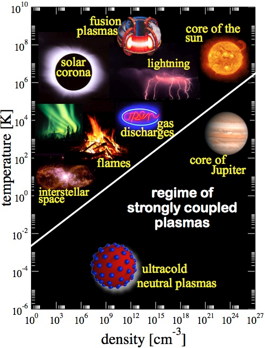
Ultracold Plasma
Plasmas are known to be the most common form of matter in the universe. Normally, the development of an ionized plasma state requires large temperatures, ranging from a few million Kelvin in the solar corona to about a thousand Kelvin in flames.
Photoionization of laser-cooled atom clouds has now made it possible to tremendously stretch this boundary and to produce plasmas with electron temperatures of 1 Kelvin and ion energies as low as one millionth of a Kelvin. Beyond opening up a new regime of plasma physics, such ultracold neutral plasmas are appealing, because they realize situations where electrostatic interactions between the charges dominate their random thermal motion. Such systems are called strongly coupled plasmas and are otherwise realized in very dense objects such as the core of Jupiter.
We use different many-body simulation methods, kinetic approaches as well as Monte-Carlo calculations to develop a theoretical understanding of the static properties and the complex dynamical behavior of ultracold neutral plasmas. In particular, we study collective phenomena, relaxation and transport processes as well as collision physics in the low-temperatures domain. Over the past years, a number of powerful tools have been developed to experimentally probe various aspects of the plasma dynamics. Here, the synergy of theory and experiment allows to test theoretical concepts, which are also important to problems in other fields, such as astrophysics.
Collaborations:
- Thomas C. Killian (Rice University, Houston TX, USA)
- Hossein R. Sadeghpour (ITAMP, Harvard-Smitsonian Center for Astrophysics, Cambridge MA, USA)
- Daniel Vrinceanu (Los Alamos National Laboratory, Los Alamos NM, USA)

Exymples of neutral plasma as a produced in the laboratory or found in nature. The diagonal line marks the sparsely occupied regime of strong coupled plasma.